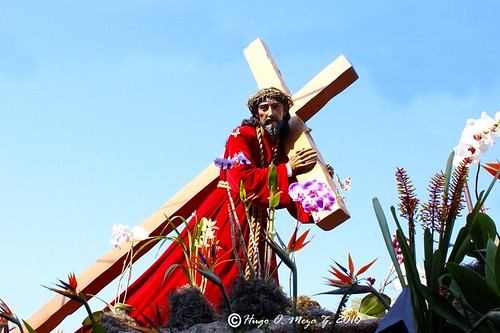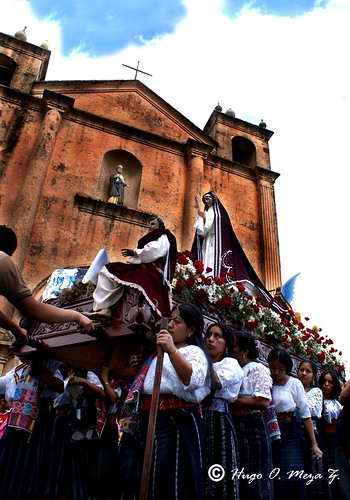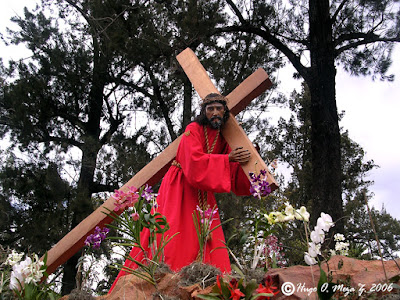Esto gracias a que la Iglesia Católica de la Colonia, trajo maestros muy reputados de España, los cuales dejaron una hermosa galería de obras, pero también sentaron cátedra, y como se deduce del producto la semilla cayó en tierra fértil.
En la Guatemala Colonial, la gente era muy devota (no había mucho para entretenerse), y las familias empezaron a llevar a sus casas la devoción que se instruía en las iglesias. De esa cuenta hasta la época Liberal de Justo Rufino Barrios, ( Antiguo Presidente de Guatemala en 1871) hubo gran cantidad de artesanos escultores, pues cada hogar debía tener al menos dos elementos imprescindibles, uno era el misterio de navidad, ( José , María y el niño Jesús) que en la época de la colonia, pues eran de estilo barroco, policromadas y estofadas en oro y plata además de ser de "bulto" como les llamamos acá (talla completa sin movimiento),y el otro elemento era el crucificado; esto continuó durante el traslado de la Antigua Guatemala, hacia la Nueva Guatemala De La Asunción, que así se llama nuestra ciudad capital. Era tal la demanda de imágenes que hasta había barrios de escultores de imágenes, como el barrio de San José, donde vivían una gran cantidad de ebanistas y talladores de madera.
Con la llegada de la revolución liberal de Justo Rufino Barrios (1871), mucho de los tesoros de la iglesia se perdieron, pues es sabido que el ejercito entraba caballo a los templos a derribar, quemar y desbaratar todo aquello que significó el dominio de la iglesia católica en nuestro país, incluyendo la expulsión de las órdenes domínicas franciscanas y demás, muchas piezas fueron a parar a manos privadas , otras fueron robadas y vendidas en el extranjero y muchísimas se perdieron para siempre.
Sin embargo la fé del Guatemalteco estaba muy enraizada, y siempre cada hogar tenía sus imágenes. ya que por un tiempo las ocultaban de toda persona que fuera de carácter militar y del Gobierno de ese entonces. Con el cambio de época vinieron nuevos aires y el barroco se enterró y quedo al mando de Martín De Mayorga capitán general de Guatemala y luego virrey de México, quien ordenó "quemar todo esas imágenes y oro de los templos, dando paso al neoclasicismo sobre el cual se construyó la nueva Guatemala.
Así también nuestros artesanos evolucionaron, y por cuestión de modas, los misterios empezaron a hacerse para vestir es decir con goznes en brazos y piernas, que es lo que actualmente esta en uso y muy pocas imágenes rescatadas de familias que conservaron las imágenes que para esa época serian ya antigua y aun más ahora.
Persiste en Guatemala muchos artesanos y escultores, que se muestra desde las artesanía típicas (Artesanía de personas indígenas) que son rústicos en madera y barro pero muy bellos, y los hay del tipo clásico. Como todo lo bueno tiene un final, en Guatemala, por razón de la economía y la guerra, muchos campesinos y pensadores emigraron a Estados Unidos, y al regresar traían las costumbres del Norte, es decir se volvieron protestantes, el siglo XIX éramos 99.9% católicos, en siglo XX 65%, en siglo XXI 55% protestantes 45% católicos. Lo que es más preocupante es que aquí se han venido a asentar las sectas súper ortodoxas protestantes, es decir aquellas que ordenan a sus fieles quemar las imágenes de los paganos, desterrar sus costumbres (que incluye no comer ni celebrar ciertas fechas, como el día de todos los santos, que se festeja comiendo una ensalada con embutidos que llamamos "Fiambre", el bacalao de cuaresma y otras) ; Yo he visto "conversos" de familias pudientes quemar en grandes hogueras muchas imágenes del barroco heredadas por generaciones, es triste para los que aun profesamos la regiolidad Católica, ya que nuestras costumbres no es Adorar a las imágenes , ya que nosotros las miramos y veneramos como una representación del suceso Católico, (Jesús , María y otros) , por lo cual muchas Familias que cambian de religión se desasen de estas Esculturas.
Hoy En día , el Arte de las Esculturas Antiguas es , muy poca, ya que prácticamente las personas que quedan aun con este don de ser Escultores, son Restauradores de Imágenes Antiguas, por lo cual ya son muy pocos y la mayoría vive aun en La Antigua Guatemala.
Autores:
César Penagos
Hugo Meza
Derechos Reservados
Hugo Orlando Meza Z.
hugoorlando00@gmail.com
INGLES
COLONIAL SCULPTURE OF GUATEMALA:
Guatemalan colonial sculpture is considered one of the best of Spanish America, surpassing in beauty and technical support to Peru and Mexico. (of course there are exceptions)
This thanks to the Catholic Church in the Colony, brought highly reputed teachers from Spain, which left a beautiful gallery of works, but also lecturing, and as is clear from the product the seed fell on fertile soil.
In Colonial Guatemala, the people were very pious (there was not much for entertainment), and families began to take home the devotion that was instructed in the churches. From that account until the time of Justo Rufino Barrios Liberal, (Former President of Guatemala in 1871) was a lot of artisans sculptors, for every home should have at least two essential elements, one being the mystery of Christmas, (Joseph, Mary and Baby Jesus) in the colonial era, they were Baroque polychrome and gold and silver stewed in addition to being the "package" as we call them here (full size without moving), and the other element was crucified , And this continued for the transfer of the Antigua Guatemala, to the New Guatemala De La Asuncion, which is the name our capital city. Such was the demand for pictures that had neighborhoods sculptors of images, as the district of San José, where they lived a lot of carpenters and wood carvers.
With the advent of the liberal revolution of Justo Rufino Barrios (1871), many of the treasures of the church were lost, it is known that the army came riding down the temples, burning and derail everything that meant the domain of Catholic Church in our country, including the expulsion of the Dominican Order Franciscan and others, many pieces were in private hands, others were stolen and sold abroad and many are lost forever.
But the Guatemalan faith was deeply rooted, and provided each household had their images. because for a while hiding from anyone outside the military and the government of the time. With changing times came new life and the Baroque was buried and remained in command of Martín De Mayorga captain general of Guatemala and then viceroy of Mexico, who ordered "burn all those images and gold of the temples, gave way to neoclassicism on which built the new Guatemala.
Guatemalan colonial sculpture is considered one of the best of Spanish America, surpassing in beauty and technical support to Peru and Mexico. (of course there are exceptions)
This thanks to the Catholic Church in the Colony, brought highly reputed teachers from Spain, which left a beautiful gallery of works, but also lecturing, and as is clear from the product the seed fell on fertile soil.
In Colonial Guatemala, the people were very pious (there was not much for entertainment), and families began to take home the devotion that was instructed in the churches. From that account until the time of Justo Rufino Barrios Liberal, (Former President of Guatemala in 1871) was a lot of artisans sculptors, for every home should have at least two essential elements, one being the mystery of Christmas, (Joseph, Mary and Baby Jesus) in the colonial era, they were Baroque polychrome and gold and silver stewed in addition to being the "package" as we call them here (full size without moving), and the other element was crucified , And this continued for the transfer of the Antigua Guatemala, to the New Guatemala De La Asuncion, which is the name our capital city. Such was the demand for pictures that had neighborhoods sculptors of images, as the district of San José, where they lived a lot of carpenters and wood carvers.
With the advent of the liberal revolution of Justo Rufino Barrios (1871), many of the treasures of the church were lost, it is known that the army came riding down the temples, burning and derail everything that meant the domain of Catholic Church in our country, including the expulsion of the Dominican Order Franciscan and others, many pieces were in private hands, others were stolen and sold abroad and many are lost forever.
But the Guatemalan faith was deeply rooted, and provided each household had their images. because for a while hiding from anyone outside the military and the government of the time. With changing times came new life and the Baroque was buried and remained in command of Martín De Mayorga captain general of Guatemala and then viceroy of Mexico, who ordered "burn all those images and gold of the temples, gave way to neoclassicism on which built the new Guatemala.
So our craftsmen evolved, and for reasons of fashion, the mystery began to get to wear that is hinged on arms and legs, which is currently in use and very few images rescued from families who kept the images for that and old age would be even more now.
Guatemala persists in many artisans and sculptors, shown from typical crafts (Craft indigenous people) that are rustic wood and mud but very beautiful, and there are the classic type. Like all good things come to an end, in Guatemala, because of the economy and the war, many farmers and thinkers emigrated to the United States and brought back the custom of the North, ie became Protestant, the nineteenth century were 99.9% Catholics in the twentieth century 65%, 55% century Protestant 45% Catholic. What is more worrying is that here you have come to lay the super-orthodox Protestant sects, ie, those who order his followers burn pictures of the pagans, banish their habits (which includes not eat or hold certain dates, such as day All Saints, celebrated by eating a salad with sausages called "Luncheon", cod Lent and others), I have been "converted" from wealthy families in large fires burning a lot of pictures of the Baroque legacy for generations, it is sad for those who still profess the Catholic regiolidad because our customs is not worship to images, as we look at them and worship as representing the Catholic event, (Jesus, Mary and others), so many families that change desasen religion of these sculptures.
Today, the Art of Ancient Sculpture is very low, because people who are virtually even with this gift of being a sculptor, are restored from old images, so there are very few and most still live in Antigua Guatemala.
Authors:
César Penagos
Hugo Meza
All Rights Reserved
Orlando Meza Hugo Z.
hugoorlando00@gmail.com








































